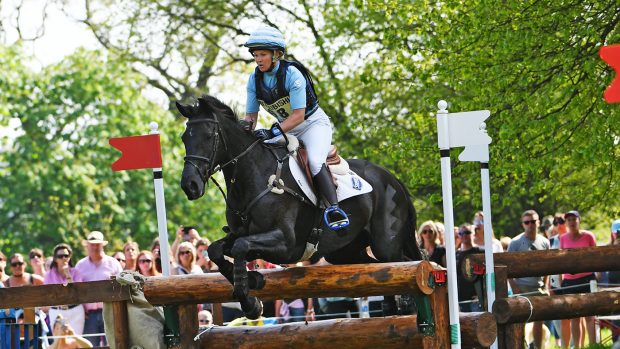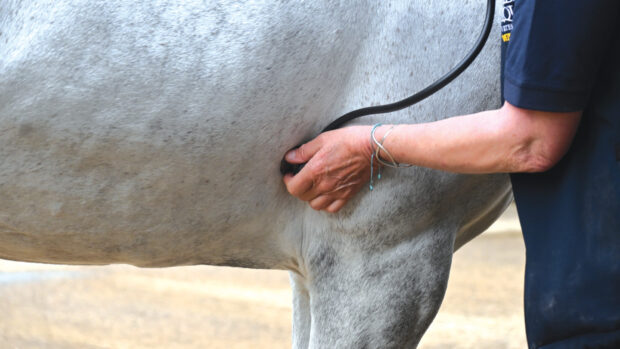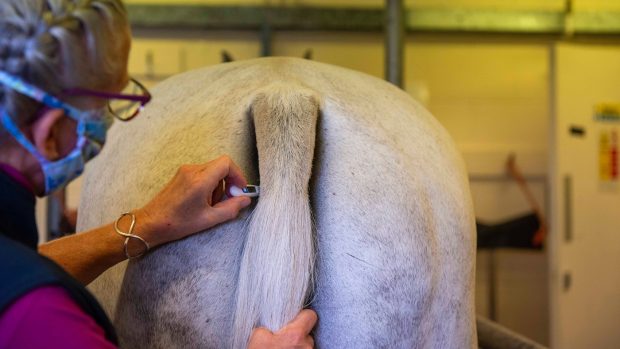The ethics around different breeding techniques – and how far is too far – have come under discussion by industry experts.
At the British Equine Veterinary Association (BEVA) Congress (13–16 September), in a debate chaired by former BEVA president Huw Griffiths, an expert panel discussed equine assisted reproductive techniques (ARTs), framed around the question “How far is too far?”. The aim was to explore which ARTs are “pushing the boundaries” in terms of animal welfare and social licence, and empower vets to have more evidence when advising a client if they do not believe it’s appropriate in certain cases to go ahead with a procedure.
World Horse Welfare chief executive Roly Owers opened the debate and said when thinking about how far is too far, vets need to consider ethics and welfare and that it is important to make sure everyone is “on the same page”. He referred to the BEVA panel discussion on what good welfare means, reported in H&H last week (news, 19 October).
Mr Owers highlighted the need to reflect on how efficient current breeding is for the horse sport market and discussed research published this year showing that within any given year, only around one-fifth of horses bred for sport will have a long-term career in equestrian sport; with the others withdrawing owing to reasons including lack of ability or injury.
“Maybe we should be thinking about how we can improve this system, before we breed more,” he said. “People often think it’s the large breeders that create all the problems, but that is not true – far more horses come from the individual breeder, breeding one animal at a time.”
Mr Owers concluded that some areas the industry needs to focus on are lack of research around ARTs, what plans have been made for a foal’s future, particularly if it does not fulfil its breeder’s expectations, whether pain involved with ARTs is assessed well enough and whether fertility clinics should be licenced.
Madeleine Campbell, who was an equine reproduction specialist prior to focusing on equine ethics and welfare, discussed the term “the yuck factor”, where consideration had to be given to society’s views on nature and ethics and whether using ARTs is “interfering more than humans ought to be”. She also mentioned looking at breeding holistically and giving consideration to the impact at breed, species, societal, and environmental levels.
“Breeding is ethically different from any other veterinary intervention, other than blood collection. The reason is that we do this thing to the horse, whatever it may be, without the expectation that we are going to improve the horse’s health by doing it,” she said.
“Every other veterinary intervention we do, we are trying to improve the health of an animal. And it’s not any one animal we’re talking about – we’ve got a mare and a stallion, we’ve often got recipient mares involved. And it’s not only one generation – we’re talking about future animals.
“As we start to move towards the possibility of genetic editing of embryos in a commercial setting, then we open up the option that we will permanently alter something for all future animals from that one onwards, so ethically that is a big thing to be thinking about.”
Veterinary reproduction specialists Camilla Scott, Tom Stout and Emma Lorenzen presented different cases involving the use of ARTs, such as ovum pick-up (OPU – where oocytes are aspirated from the mare’s ovary) and intra-cytoplasm sperm injections (ICSI – where a single sperm is injected through the outer surface of a mature oocyte) and talked about the success rates and benefits. In one example, a top showjumping mare had died, and using ICSI, oocytes were recovered and a foal was bred who went on to become a successful licensed stallion.
The complications associated with the procedures in different horses – including pain – were also discussed, and when ARTs are appropriate or not. It was agreed across the board that pain control during ART procedures needs to be a major focus.
One attendee said he believed there were two sides to the use of ARTs.
“One is how can we exercise these various techniques while keeping the discomfort to a minimum? The second is how do we communicate to the public to keep our social licence?” they said. “I think social licence varies a lot based on the level of knowledge about the technique. It seems that the less people know about a particular technique, the more important the ‘yuck factor’ becomes.”
The overpopulation of horses was also discussed, in terms of horses who do not stay sound and end up unwanted. And one attendee highlighted the benefits of ARTs where horses can be bred who are healthier and more specifically targeted for a purpose.
Professor Campbell said it is not just the responsibility of vets to consider breeding decisions and the use of ARTs, but also breeders.
“Breeders need to not be aiming to produce horses that look amazing when they are four, but are then crippled when they are eight,” she said, adding that there is a need to have more data and to track horses bred via ARTs to record if they develop any health problems later in life.
In conclusion, it was agreed that group discussions on ARTs and breeding are “vital” and should be ongoing to maintain trust across the industry and with the public.
“It’s good to build up the evidence base. We need to start building our own guidelines and regulating ourselves, if we don’t then it’s our own fault when other people step in and try to regulate us,” Professor Stout.
You might also be interested in:

Is it right to give horses ‘one last summer’? Vets discuss what good welfare really means

‘Hearts and minds’: how changing owner behaviour can help our horses

Subscribe to Horse & Hound magazine today – and enjoy unlimited website access all year round
Horse & Hound magazine, out every Thursday, is packed with all the latest news and reports, as well as interviews, specials, nostalgia, vet and training advice. Find how you can enjoy the magazine delivered to your door every week, plus options to upgrade your subscription to access our online service that brings you breaking news and reports as well as other benefits.




